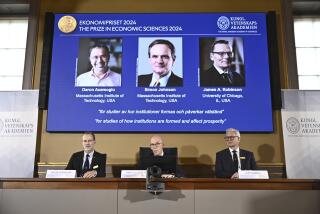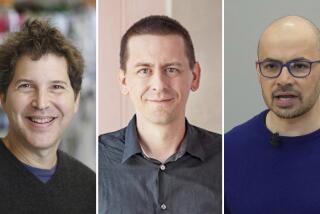Nobel Prize Awarded to USC Chemist : Science: George Olah is recognized for work with hydrocarbons. An American and a Canadian share physics award.
- Share via
A University of Southern California chemist whose mastery of the most powerful acids known helped pave the way for less polluting gasoline, more effective oil refining and many modern drugs won the Nobel Prize for chemistry, the Royal Swedish Academy of Sciences announced Wednesday.
George A. Olah, who fled first to Canada, then to the United States after a 1956 Soviet military crackdown in his homeland of Hungary, has almost single-handedly established USC as a notable center of advanced industrial chemistry, scientists and university officials said.
The Swedish Academy on Wednesday also awarded the Nobel Prize in physics to Clifford Shull, 79, a physicist who has retired from the Massachusetts Institute of Technology, and Canadian Bertram Brockhouse, 76, of McMaster University in Ontario. Working independently, they made pioneering contributions to the studies of condensed matter.
Olah, 67, a genial grandfather whose receding crown of steel gray hair frames a craggy profile and an avuncular smile, said Wednesday that he is giving the $945,000 prize money to his wife, Judith Olah, a chemist who worked with him in the laboratory until her retirement four years ago. She handles the family finances, he said.
Asked about their professional collaboration, she said, “He was a marvelous boss. I mean we are still married after working (together) since 1955. That should tell you everything.”
As he raised a crystal flute of champagne to toast the award, Olah clearly was savoring more than the heady bubbles of the wine. He grinned at USC President Stephen Sample and said, “We will put USC on the map for something different than football.”
The award cited his discovery of how to make concentrated solutions of unusual hydrocarbons in what he calls magic acids, creating an entire new field of chemistry of considerable theoretical, and practical, importance.
The potent acids--billions of times stronger than conventional acids--are able to activate organic chemical compounds, called carbocations, in reactions that were previously thought to be impossible.
“Hydrocarbons are the raw materials of many things we use in daily life, of oil and natural gas, and we take them for granted,” Olah said. “Look around, practically everything is touched by hydrocarbons. They are used for making gasoline, pharmaceuticals and plastic, so it is very important to understand the process by which hydrocarbons are transformed.”
Olah holds more than 100 patents, including some for work that led to lead-free gasoline and several drugs. He has authored more than 900 research papers and has helped shape the development of organic chemistry in the second half of the 20th Century, colleagues said.
“The direction of this field did change completely through the original and imaginative work by this year’s Nobel Prize laureate,” the academy said.
In his office Wednesday, Olah sat surrounded by chemical texts stacked 12 deep and basked in congratulatory telephone calls from around the world, including Hungary, while his colleagues beamed and tossed confetti.
“It is just wonderful,” Olah said. He singled out for praise his longtime collaborator, Surya Prakash, at USC’s Loker Hydrocarbon Research Institute, which Olah directs.
Olah grew up in Budapest between World Wars I and II. He never gave a thought to becoming a scientist, he said, until after graduating from high school.
“I was interested in history and many other things. Thank God I never pursued them. Who is interested in medieval Hungarian history?” he said.
He joined the USC faculty in 1977 after a decade at Case Western Reserve University in Cleveland, where his work earned him membership in the National Academy of Sciences.
Of the research that led to his Nobel Prize, he said there was never a flash of dazzling insight, no eureka moment. Instead, his discoveries were the result of unusually long hours of laboratory routine that typically began just after dawn and continued until 10 at night.
“Scientist are like kids who try to search for the new and unexpected. But you don’t come into your lab at 9 in the morning and say today I am going to make a great fundamental discovery.”
Olah’s work is distinguished by its immense practical applications. He spoke forcefully in support of the kind of goal-oriented research that, among many funding agencies, is rapidly overtaking the more traditional pursuit of basic knowledge for its own sake.
“There is nothing wrong, all things being equal, in doing something that may be of some use. Some people think you are tainted if you do something that is even remotely practical. I think it is a challenge to do something that also has some practical use,” he said.
While Olah is still actively pursuing his research, the two men who share the physics prize retired years ago.
Brockhouse and Shull made their discoveries at the dawn of the nuclear age almost 40 years ago. Working with relatively primitive nuclear reactors, they helped develop powerful methods of analyzing matter when X-rays and microscopes cannot see enough detail, called neutron scattering techniques.
“In simple terms, Clifford G. Shull has helped answer the question of where atoms ‘are’ and Bertram N. Brockhouse the question of what atoms ‘do,’ ” academy officials said in announcing the award.
Brockhouse, 76, now lives in Hamilton, Ontario, an industrial center and university town of 315,000 people about 45 miles west of Toronto. At a news conference at McMaster University in Hamilton, where he taught from 1962 until his retirement in 1984, he appeared less excited than his former colleagues in the physics department, who beamed and applauded their mentor.
Dressed in a tweedy gray jacket over a taupe pullover, Brockhouse described himself as “an intellectual explorer” and likened his pioneering work with the atom to that of a geological map maker who lays down the basic chart that other scientists use to mine practical, everyday applications.
“What we work on with basic science is just a bigger atlas with places and objects and so on that are not as familiar in ordinary life as is the earth and the air and sea and the rocks,” he said. “ . . . What my work did . . . is just add some more information, some more insight into what this world, this physical world, is.”
Brockhouse, a native of Lethbridge, Alberta, began dissecting the inner workings of the atom at Canada’s Chalk River Nuclear Laboratories near Ottawa. The work cited for the Nobel continued through the 1950s and into the early 1960s after he joined the McMaster faculty, he said.
Brockhouse explored the movement or dynamics of atoms in solid and electric matter through a process called thermal neutron scattering. He developed the triple axis crystal spectrometer and other neutron scattering instruments and techniques that are the basis for methods still used today.
He said he was driven by the challenge of the unknown.
“For a very long time before I actually became a scientist, it was science that I wanted to do,” he said. “Of course, it’s characteristic of research, real research, that you don’t know what you’re going to do. All you know is where you stand at the moment and some vague intuitions of where you might go from there.”
His reaction to the prize, he said, was “enormous astonishment, of course.”
He said he has “no idea” what he will do with the money that accompanies the prize, but suggested that he might use the stature that adheres to a Nobelist to promote the cause of energy conservation and other environmental issues about which he feels strongly.
By studying simple compounds such as table salt, Shull and his colleagues discovered that neutrons are deflected in a distinctive pattern when they strike a sample of material. That allows researchers to determine the sample’s atomic structure. Shull performed his original experiments almost 50 years ago at the federal laboratory at Oak Ridge, Tenn., then continued his work at MIT.
Hotz reported from Los Angeles and Turner from Hamilton, Canada. Times staff writer Ching Ching Ni contributed to this story.
* JOY ON CAMPUS: USC has had plenty of Heismans but never a Nobel. B1






